How to eat healthy in 2016
You’re determined to eat healthier this year. Now what?
The start of a new term is a time when many people resolve to adopt healthier behaviours, including eating better. This is a useful goal for anyone — including Concordians. The 2013 National College Health Assessment revealed that only 13 per cent of the university's students eat at least five servings of fruits or vegetables per day.
It’s not enough to say, “I will eat healthier.” Plan for change, and approach it in a structured way to increase your chances of success.
Here are 4 steps to a healthy diet
1) Set a S.M.A.R.T. goal
S.M.A.R.T. stands for Specific, Measurable, Action-oriented, Realistic and Time-bound.
Examples of S.M.A.R.T. healthy eating goals are:
- I will include a serving of fruit or vegetable every time I eat
- I will prepare my own lunch at least three times a week
- Every day I will eat according to the Canada Food Guide and will have eight servings of fruits and vegetables, six servings of grains, etc.
2) Build commitment to your goal
To commit to your goal, you need to see it as important and believe that you can achieve it.
One way to build commitment is to tie your healthy eating goal to your values and other life goals. For example, if you place importance on financial stability and are a student who would like to graduate debt-free, preparing meals for yourself will help you keep those goals in line. Preparing food at home will also help you eat better because takeout foods are often less nutritious than what you make for yourself.
Watch the video Tips for healthy eating on a budget to find out how to make good meals at home for less, and consult the How to Effectively Set, Achieve and Maintain Health Goals guide for several activities to help you build your commitment.
3) Make a plan
Identify:
- Skills you need (for example, cooking)
- Information you need (just what is one serving of vegetables, anyway?)
- Changes you can make to your environment (empty that cupboard full of high-fat snacks in your kitchen)
- Support you can get from others (share grocery shopping responsibilities with roommates)
- Any other tasks to achieve your goal
4) Monitor
Monitoring helps you stay on track — but you don’t need to count calories!
- Fill a container with several servings of chopped veggies for snacking; make sure it is empty at the end of the day
- Buy takeout with cash only; when the pre-determined amount is gone, you know you’ve reached your limit for the week
- Use this monitoring sheet from Health Services indicating Food Guide servings
If you achieved your goal, ask yourself: What helped? Keep doing it! If you didn’t achieve your goal that day, ask yourself: What obstacle did I encounter? What will I do differently tomorrow?
It’s all about choices
A healthy diet is a plant-based diet. This means choosing fruit, vegetables and grains — mostly whole grains — more often. You can also choose protein-rich plant foods instead of meat. Plant foods that are a source of protein include beans, nuts and seeds.
Canada’s Food Guide offers an overview of healthy eating and is a great place to start.
It recommends:
- Eating a diet rich in plant foods
- Choosing plant-based alternatives often
- Eating a diet low in total fat, saturated fat, sodium and added sugars
- Limiting trans fats and hydrogenated fats, found mostly in commercially prepared baked goods (such as cookies, crackers, cakes and pies), shortening and some margarines
- Eating regularly throughout the day
- Eating a variety of foods
- Eating real food, not “junk” such as fast food and highly processed foods
- Quenching your thirst with water more often than sweet beverages
Health Services' website summarizes the basics of good eating. More tips and information are also available on Food Services' website.
The choices we make are shaped by the choices that are available to us.
Having easy access to fresh, affordable fruits and vegetables on campus could make it easier for you to make healthier food choices every day. Check out the hot spots on campus for hungry students.
Cooking classes
There is much to learn from the cooking classes at the PERFORM Centre. Along with the traditional cooking courses, such as Mediterranean Diet and Plant-based Diet, there’s a new option called Cooking Ensemble, which costs $55/person and takes place on February 4 or 11, 6 to 8 p.m. at the PERFORM Nutritional Teaching Lab S1.223.
It provides a communal experience for participants who want to cook and prepare simple, nutritious and affordable recipes. Participants cook five different recipes to take home, with the option of purchasing additional portions. Reserve your place by calling 514-848-2424, ext. 2829.
If you’d like an Individual Nutrition Program or more information about the PERFORM Centre’s cooking classes, contact Théa Demmers at thea.demmers@concordia.ca 514-848-2424 ext. 4018.
Finally, we’re here to help
Health promotion specialists are available for free consultations to help you achieve your health goals, including eating well. Contact Gaby Szabo or Owen Moran to book an appointment.
A few more resources
- Harvard’s Nutrition Source
- Nutrition Action Health Letter (on CLUES)
- Health, in Other Words (Santé et Services sociaux Québec)
Find out more about healthy cooking classes at Concordia’s PERFORM Centre.
